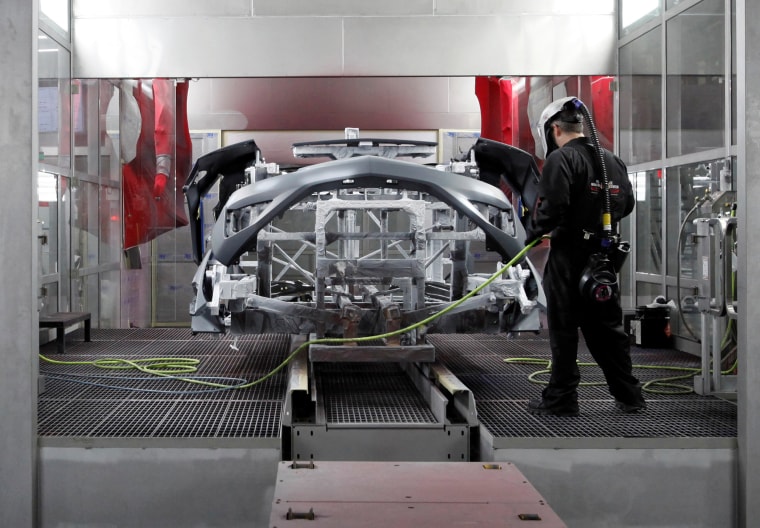June wasn’t a great month for the labor market. Economists blame President Donald Trump’s trade war — and warn that if he follows through with his protectionist agenda, he could lead America into a recession.
Friday’s announcement from the Bureau of Labor Statistics that the economy added just 75,000 jobs, well below expectations, came two days after payroll processor ADP’s report on private sector employment reported that a mere 27,000 jobs were added in May.
“Even though the ADP report earlier this week foreshadowed a possible miss for today, this is even worse than the lower band of most people’s expectations,” said Chris Zaccarelli, chief information officer for the Independent Advisor Alliance.
“This is a clear warning sign that the trade war is doing serious damage to the economy,” said Mark Zandi, chief economist at Moody’s Analytics. “The fingerprints of the trade war are increasingly evident in the data.”
Weakness in manufacturing jobs, which were flat in May, is one big clue, he said. “Job growth in manufacturing last year was averaging 20,000 to 25,000 per month. This year, it’s barely positive.” May’s loss of retail and transportation jobs also reflects the impact of shrinking margins and a constriction in global trade, he added.
Several labor economists highlighted manufacturing in particular. Although the Trump presidency has been defined by an oft-stated commitment to support American manufacturers, the trade war is costing far more jobs than it has added, and the sector’s woes might only be beginning, said Glassdoor.com senior economist Daniel Zhao.
Trump’s presidency has been defined by a pledge to support American manufacturers, but the trade war is costing far more jobs than it has added, said one economist.
Zhao said Glassdoor’s own internal data also reflected a contraction. “We’ve seen declining job openings, which could signal that the slowdown in manufacturing could actually worsen in the near future.”
With the economy on an upward trajectory for an unprecedented decade-long run, a slowdown was inevitable at some point. Labor market experts had been expecting a gradual winding-down, but trade tensions have thrown out the playbook for their expectations about its speed and severity.
Economists warned that a race toward tariffs could quickly put any job gains in the rear-view mirror, and could send the American economy barreling into a recession. “If the president continues to pursue the war, certainly if he escalates things, I think recession risks rise,” Zandi said.
Trump’s strategy of wielding tariffs as a catch-all instrument for reshaping everything from global supply chains to geopolitical alliances could break the economy’s long string of job gains sooner than expected, predicted Josh Wright, chief economist at iCIMS.
“Next month it’s definitely possible, given the severity of these headlines. This is a fast-moving situation,” Wright said. “Things could get a lot worse over the course of this month.”
Wright said this will challenge the Federal Reserve to chart a path forward that threads the needle between inflation and growth without making a mistake. “It actually makes the conversation harder,” he said. “This makes it easier for the Fed to make the case for rate cuts, but I don’t think this is enough on its own.”
“The stock markets are banking on the Fed’s ability to step in and save the day, as it has for much of the last decade,” said Cliff Hodge, director of investments for Cornerstone Wealth.
In a recovery characterized by an extended stretch of historically low interest rates, though, the Fed’s ability to ward off an economic slide may be diminished. “The Fed has less room to use monetary policy to stimulate the economy,” Zhao said. “There’s still room for the Fed to work with, but if the economy were to slow down more dramatically, that certainly would be a concern.”
For now, job growth remains in positive territory even though both the BLS and ADP reports on job gains turned out to be unpleasant surprises. This gives market observers a measure of hope.
“Ultimately, the labor market is still running hot enough to keep burning in the future,” Zhao said. “This report indicates that employers are taking their foot off the gas. They’re not hitting the brakes quite yet, but it definitely is a warning sign for the economy moving forward.”
Although the unemployment rate remained steady at 3.6 percent, Zhao said weaker wage growth and labor force participation were a bad sign. “Those two signals do indicate an even weaker report than just the topline numbers imply,” he said.
Downward revisions to March and April reports that shaved another combined 75,000 jobs off the total added to Zandi’s concern. “That’s another indication that the economy is really turning. That’s when you get these downward revisions,” he said.
Shutting down the multifront trade war now — including Trump’s threats to levy tariffs on all Chinese and Mexican imports, as well as on imported vehicles — could bring the economic trajectory back to normal, but that window is closing fast, Zandi said.
“If he follows all the way through… then we’re done. Game over. I think we have a recession.”
